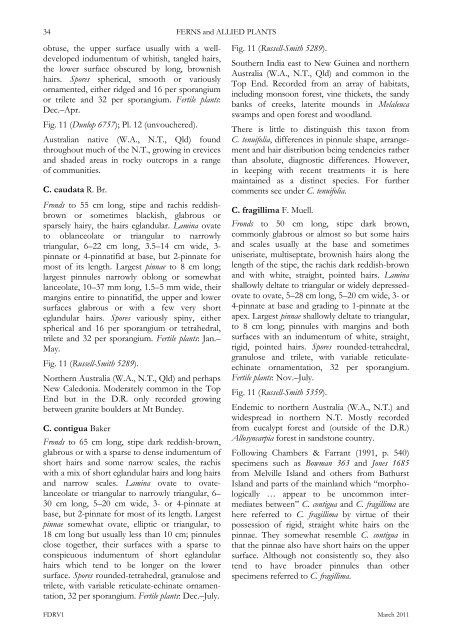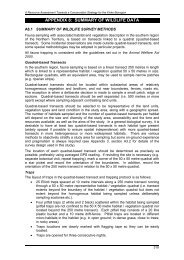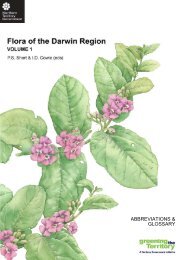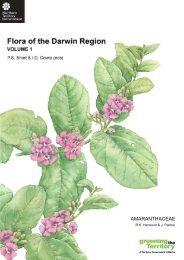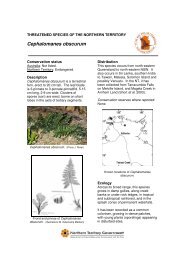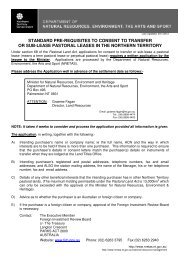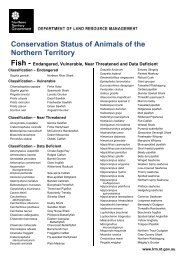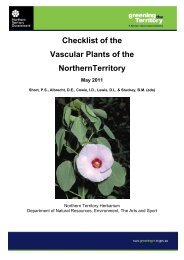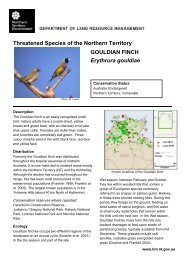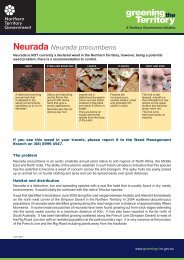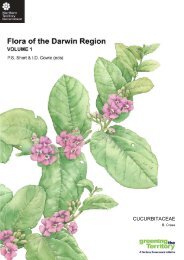ferns and allied plants - Department of Land Resource Management ...
ferns and allied plants - Department of Land Resource Management ...
ferns and allied plants - Department of Land Resource Management ...
You also want an ePaper? Increase the reach of your titles
YUMPU automatically turns print PDFs into web optimized ePapers that Google loves.
34<br />
obtuse, the upper surface usually with a welldeveloped<br />
indumentum <strong>of</strong> whitish, tangled hairs,<br />
the lower surface obscured by long, brownish<br />
hairs. Spores spherical, smooth or variously<br />
ornamented, either ridged <strong>and</strong> 16 per sporangium<br />
or trilete <strong>and</strong> 32 per sporangium. Fertile <strong>plants</strong>:<br />
Dec.–Apr.<br />
Fig. 11 (Dunlop 6757); Pl. 12 (unvouchered).<br />
Australian native (W.A., N.T., Qld) found<br />
throughout much <strong>of</strong> the N.T., growing in crevices<br />
<strong>and</strong> shaded areas in rocky outcrops in a range<br />
<strong>of</strong> communities.<br />
C. caudata R. Br.<br />
Fronds to 55 cm long, stipe <strong>and</strong> rachis reddishbrown<br />
or sometimes blackish, glabrous or<br />
sparsely hairy, the hairs egl<strong>and</strong>ular. Lamina ovate<br />
to oblanceolate or triangular to narrowly<br />
triangular, 6–22 cm long, 3.5–14 cm wide, 3pinnate<br />
or 4-pinnatifid at base, but 2-pinnate for<br />
most <strong>of</strong> its length. Largest pinnae to 8 cm long;<br />
largest pinnules narrowly oblong or somewhat<br />
lanceolate, 10–37 mm long, 1.5–5 mm wide, their<br />
margins entire to pinnatifid, the upper <strong>and</strong> lower<br />
surfaces glabrous or with a few very short<br />
egl<strong>and</strong>ular hairs. Spores variously spiny, either<br />
spherical <strong>and</strong> 16 per sporangium or tetrahedral,<br />
trilete <strong>and</strong> 32 per sporangium. Fertile <strong>plants</strong>: Jan.–<br />
May.<br />
Fig. 11 (Russell-Smith 5289).<br />
Northern Australia (W.A., N.T., Qld) <strong>and</strong> perhaps<br />
New Caledonia. Moderately common in the Top<br />
End but in the D.R. only recorded growing<br />
between granite boulders at Mt Bundey.<br />
C. contigua Baker<br />
Fronds to 65 cm long, stipe dark reddish-brown,<br />
glabrous or with a sparse to dense indumentum <strong>of</strong><br />
short hairs <strong>and</strong> some narrow scales, the rachis<br />
with a mix <strong>of</strong> short egl<strong>and</strong>ular hairs <strong>and</strong> long hairs<br />
<strong>and</strong> narrow scales. Lamina ovate to ovatelanceolate<br />
or triangular to narrowly triangular, 6–<br />
30 cm long, 5–20 cm wide, 3- or 4-pinnate at<br />
base, but 2-pinnate for most <strong>of</strong> its length. Largest<br />
pinnae somewhat ovate, elliptic or triangular, to<br />
18 cm long but usually less than 10 cm; pinnules<br />
close together, their surfaces with a sparse to<br />
conspicuous indumentum <strong>of</strong> short egl<strong>and</strong>ular<br />
hairs which tend to be longer on the lower<br />
surface. Spores rounded-tetrahedral, granulose <strong>and</strong><br />
trilete, with variable reticulate-echinate ornamentation,<br />
32 per sporangium. Fertile <strong>plants</strong>: Dec.–July.<br />
FERNS <strong>and</strong> ALLIED PLANTS<br />
Fig. 11 (Russell-Smith 5289).<br />
Southern India east to New Guinea <strong>and</strong> northern<br />
Australia (W.A., N.T., Qld) <strong>and</strong> common in the<br />
Top End. Recorded from an array <strong>of</strong> habitats,<br />
including monsoon forest, vine thickets, the s<strong>and</strong>y<br />
banks <strong>of</strong> creeks, laterite mounds in Melaleuca<br />
swamps <strong>and</strong> open forest <strong>and</strong> woodl<strong>and</strong>.<br />
There is little to distinguish this taxon from<br />
C. tenuifolia, differences in pinnule shape, arrangement<br />
<strong>and</strong> hair distribution being tendencies rather<br />
than absolute, diagnostic differences. However,<br />
in keeping with recent treatments it is here<br />
maintained as a distinct species. For further<br />
comments see under C. tenuifolia.<br />
C. fragillima F. Muell.<br />
Fronds to 50 cm long, stipe dark brown,<br />
commonly glabrous or almost so but some hairs<br />
<strong>and</strong> scales usually at the base <strong>and</strong> sometimes<br />
uniseriate, multiseptate, brownish hairs along the<br />
length <strong>of</strong> the stipe, the rachis dark reddish-brown<br />
<strong>and</strong> with white, straight, pointed hairs. Lamina<br />
shallowly deltate to triangular or widely depressedovate<br />
to ovate, 5–28 cm long, 5–20 cm wide, 3- or<br />
4-pinnate at base <strong>and</strong> grading to 1-pinnate at the<br />
apex. Largest pinnae shallowly deltate to triangular,<br />
to 8 cm long; pinnules with margins <strong>and</strong> both<br />
surfaces with an indumentum <strong>of</strong> white, straight,<br />
rigid, pointed hairs. Spores rounded-tetrahedral,<br />
granulose <strong>and</strong> trilete, with variable reticulateechinate<br />
ornamentation, 32 per sporangium.<br />
Fertile <strong>plants</strong>: Nov.–July.<br />
Fig. 11 (Russell-Smith 5359).<br />
Endemic to northern Australia (W.A., N.T.) <strong>and</strong><br />
widespread in northern N.T. Mostly recorded<br />
from eucalypt forest <strong>and</strong> (outside <strong>of</strong> the D.R.)<br />
Allosyncarpia forest in s<strong>and</strong>stone country.<br />
Following Chambers & Farrant (1991, p. 540)<br />
specimens such as Bowman 363 <strong>and</strong> Jones 1685<br />
from Melville Isl<strong>and</strong> <strong>and</strong> others from Bathurst<br />
Isl<strong>and</strong> <strong>and</strong> parts <strong>of</strong> the mainl<strong>and</strong> which “morphologically<br />
… appear to be uncommon intermediates<br />
between” C. contigua <strong>and</strong> C. fragillima are<br />
here referred to C. fragillima by virtue <strong>of</strong> their<br />
possession <strong>of</strong> rigid, straight white hairs on the<br />
pinnae. They somewhat resemble C. contigua in<br />
that the pinnae also have short hairs on the upper<br />
surface. Although not consistently so, they also<br />
tend to have broader pinnules than other<br />
specimens referred to C. fragillima.<br />
FDRV1 March 2011


